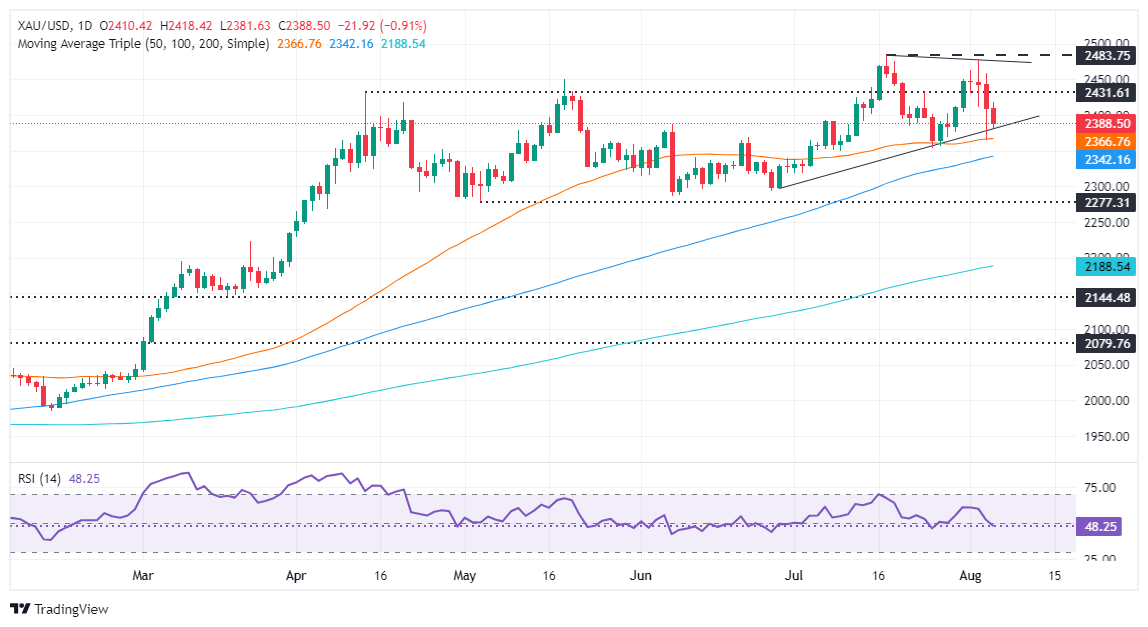- Gold price dips below $2,400, trading at $2,389, extending losses for the second consecutive day.
- Rising US Treasury yields and a stronger US Dollar weigh on bullion prices.
- Geopolitical tensions in the Middle East, with Hezbollah attacks on northern Israel, could support Gold as a safe haven.
Gold price dropped below $2,400 on Tuesday, extending its losses for the second consecutive day as US Treasury yields rose amid an improvement in market mood. Rising tensions in the Middle East capped losses in the golden metal. At the time of writing, the XAU/USD trades at $2,389, down by 0.82%.
The recovery in the financial markets resumed on Tuesday, as the Nikkei recovered and closed 10% above its opening price, following Monday’s 12% plunge. Therefore, European and US equity indices posted solid gains.
Aside from this, the Greenback remains bid, a headwind for Bullion prices. The US Dollar Index (DXY), which tracks the buck’s performance against six currencies, rose 0.30% to 102.97.
Another reason for the drop in the non-yielding metal is elevated US yields. The US 10-year benchmark note coupon climbed ten basis points (bps) to 3.892%, even though traders are bracing for a 50-bps interest rate cut by the Federal Reserve at the upcoming September meeting.
Nevertheless, geopolitical woes loom after Hezbollah launched attacks on northern Israel. A conflict escalation could bolster Gold’s prospects and even pave the way for reclaiming $2,400.
On the central bank space, Federal Reserve policymakers led by San Francisco Fed Mary Daly said the dual mandate risks had come into balance and that they’re open to lower borrowing costs in coming meetings.
Daily digest market movers: Gold price on the defensive amid risk-on mood
- Worries of a US recession had faded, shown by market mood. Despite this, traders expect the Federal Reserve (Fed) will cut interest rates by 50 basis points at the September meeting.
- Market players found some relief following the ISM Services PMI release, which revealed the economy continues to expand at a healthier pace following a dismal ISM Manufacturing PMI report and a dismal US jobs report.
- A deteriorated market mood would continue influencing traders as fears of a US recession ignited a sell-off among the largest stock market indices.
- The Fed decided to hold rates unchanged last week but indicated that favorable data on inflation and further weakening in the labor market could prompt action.
- The CME FedWatch tool shows the odds for a 50 bps Fed rate cut at the September meeting were lowered from 85% on Monday to 69.5%.
Technical analysis: Gold price slumps and hovers around $2,360
Gold price slipping below $2,400 could pave the way for a break below key support levels, dragging prices towards the May 3 low of $2,277. Momentum shifted aggressively bearishly, as depicted by the Relative Strength Index (RSI).
If XAU/USD drops below the 50-day Simple Moving Average (SMA) at $2,366, this would exacerbate a drop to the 100-day SMA At 2342, followed by a support trendline around $2,316. Once cleared, the next support would be $2,300
Conversely, if buyers reclaim $2,400, the next resistance would be the psychological $2,450 mark. A breach of the latter will expose the August 2 peak at $2,477. Followed by the all-time high at $2,483 ahead of $2,500.
Risk sentiment FAQs
In the world of financial jargon the two widely used terms “risk-on” and “risk off” refer to the level of risk that investors are willing to stomach during the period referenced. In a “risk-on” market, investors are optimistic about the future and more willing to buy risky assets. In a “risk-off” market investors start to ‘play it safe’ because they are worried about the future, and therefore buy less risky assets that are more certain of bringing a return, even if it is relatively modest.
Typically, during periods of “risk-on”, stock markets will rise, most commodities – except Gold – will also gain in value, since they benefit from a positive growth outlook. The currencies of nations that are heavy commodity exporters strengthen because of increased demand, and Cryptocurrencies rise. In a “risk-off” market, Bonds go up – especially major government Bonds – Gold shines, and safe-haven currencies such as the Japanese Yen, Swiss Franc and US Dollar all benefit.
The Australian Dollar (AUD), the Canadian Dollar (CAD), the New Zealand Dollar (NZD) and minor FX like the Ruble (RUB) and the South African Rand (ZAR), all tend to rise in markets that are “risk-on”. This is because the economies of these currencies are heavily reliant on commodity exports for growth, and commodities tend to rise in price during risk-on periods. This is because investors foresee greater demand for raw materials in the future due to heightened economic activity.
The major currencies that tend to rise during periods of “risk-off” are the US Dollar (USD), the Japanese Yen (JPY) and the Swiss Franc (CHF). The US Dollar, because it is the world’s reserve currency, and because in times of crisis investors buy US government debt, which is seen as safe because the largest economy in the world is unlikely to default. The Yen, from increased demand for Japanese government bonds, because a high proportion are held by domestic investors who are unlikely to dump them – even in a crisis. The Swiss Franc, because strict Swiss banking laws offer investors enhanced capital protection.


